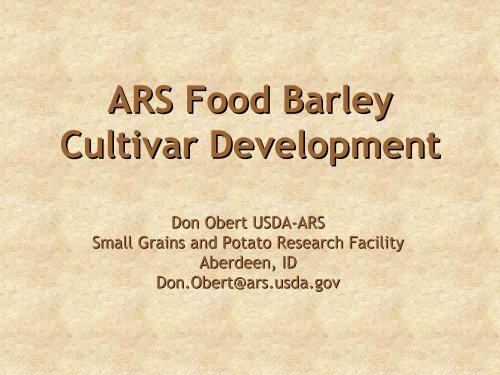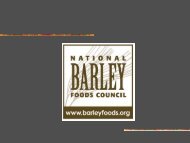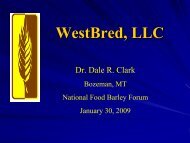New barley variety development Dr. Don Obert, ARS Small Grains and ...
New barley variety development Dr. Don Obert, ARS Small Grains and ...
New barley variety development Dr. Don Obert, ARS Small Grains and ...
Create successful ePaper yourself
Turn your PDF publications into a flip-book with our unique Google optimized e-Paper software.
<strong>ARS</strong> Food BarleyCultivar Development<strong>Don</strong> <strong>Obert</strong> USDA-<strong>ARS</strong><strong>ARS</strong><strong>Small</strong> <strong>Grains</strong> <strong>and</strong> Potato Research FacilityAberdeen, ID<strong>Don</strong>.<strong>Obert</strong>@ars.usda.gov
The harder you work the luckier you getGary PlayerPlant breeding is part art, part science,but mostly just hard workJohn Schmidt
Approximately 30,000 plots, encompassing11,000 genotypes, are evaluated each season.
IdahoBarleyProductionNorthwest counties: Latah, Lewis, <strong>and</strong> Nez Perce.South central counties: Cassia, Minidoka, <strong>and</strong>Twin Falls.Eastern counties: Bingham, Bonneville, Caribou,Fremont, Jefferson, Madison,<strong>and</strong> Teton.
Barley Breeding NurseriesPotlatchBetween actual counties<strong>and</strong> adjoining countiesthese Nurseries represent75.6% of Idaho acreageTammanyFennAberdeenAshtonTetoniaIdahoFallsFilerSodaSprings
The Breeding Process2004-05Generate PopulationDesired TraitsYieldParent 1-Parent 2+20052005100100F 1SeedF 2RowsGreenhouse<strong>New</strong> Zeal<strong>and</strong>PlumpsBeta-glucanLodgingResistance++-+-+2006 95F 3Plots Summer Field-2 locations200690F 4Rows<strong>New</strong> Zeal<strong>and</strong>200770*753,000F 5Plots12 3 4 5 6 7 8 910Evaluation at Filer for agronomics, yield<strong>and</strong> seed quality; select lines advanceBlue: advanced, Red: rejected2008 800single plots Single plot at 2 locations, Quality evaluationFrom this point forward2009 2002 replications 3 locations2010 1503 replications 4 locations2011 1003 replications 8 locations2012-15 503 replicationsElite lines (2-3) at 30 locations. Seed increase for possible release.
6080 100 120 140Distribution of food <strong>barley</strong> yields (bu/A)
Segregating lines within a population
4 5 6 7 8AzhulFalcon% Beta-glucan
The Breeding Process2004-05Generate PopulationDesired TraitsYieldParent 1-Parent 2+20052005100100F 1SeedF 2RowsGreenhouse<strong>New</strong> Zeal<strong>and</strong>PlumpsBeta-glucanLodgingResistance++-+-+2006 95F 3Plots Summer Field-2 locations200690F 4Rows<strong>New</strong> Zeal<strong>and</strong>200770*753,000F 5Plots12 3 4 5 6 7 8 910Evaluation at Filer for agronomics, yield<strong>and</strong> seed quality; select lines advanceBlue: advanced, Red: rejected2008 800single plots Single plot at 2 locations, Quality evaluationFrom this point forward2009 2002 replications 3 locations2010 1503 replications 4 locations2011 1003 replications 8 locations2012-15 503 replicationsElite lines (2-3) at 30 locations. Seed increase for possible release.
Beta-glucan Evaluation(McCleary method, AACC Method 32-33, 33, condensed version)-Evaluate composite of populations, beginning with F 4-Test 5 seed from individual plants (F 5:6 )-Evaluate composite of each at multiple locations for all replicatedyield trials- Our procedure is slightly modified to allow for high throughput testing byminimizing the reaction volumes <strong>and</strong> by incorporating cluster tubes <strong>and</strong>96-well assay plates into the final color <strong>development</strong> steps.-Microplate reader determines beta-glucan density (absorbance).
cluster tubes96 well plates
2 blanks 2 st<strong>and</strong>ardsreplicated samples01AH2812AzhulBaronesseCDC AlamoFalconGlacierHarringtonM38M351MorexSteptoeWaxbar9.1 11.8 5.0 6.4 4.7 7.0 4.9 7.6 1.6 5.0 5.9 7.1
Elite high beta-glucan lines




